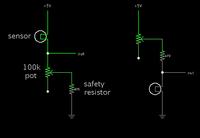aliyesami
Full Member level 6
i bought a salinity probe from Oakton which comes integrated with a temperature cable, I just learned from their engineers that they use NTC 30K thermistor. If i look at the data sheet of this thermistor i see large lookup tables between resistance and temperature.
also the temperature have a degree gap in it.
so people interfacing this thermistor have to do a lookup into these large tables for every temperature reading unlike the temperature chips like LM60 which has formulas that can be used to convert the read signal into temperature values with precision of 100 units.
thanks
https://www.vishay.com/docs/29118/ntcle203.pdf
also the temperature have a degree gap in it.
so people interfacing this thermistor have to do a lookup into these large tables for every temperature reading unlike the temperature chips like LM60 which has formulas that can be used to convert the read signal into temperature values with precision of 100 units.
thanks
https://www.vishay.com/docs/29118/ntcle203.pdf
